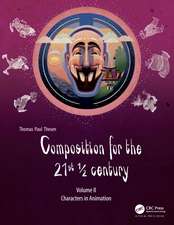Composition for the 21st 1/2 Century, 2 Volume set
Autor Thomas Paul Thesenen Limba Engleză Paperback – 29 iun 2022
Key Features
| Toate formatele și edițiile | Preț | Express |
|---|---|---|
| Paperback (1) | 774.13 lei 3-5 săpt. | +59.33 lei 4-10 zile |
| CRC Press – 29 iun 2022 | 774.13 lei 3-5 săpt. | +59.33 lei 4-10 zile |
| Hardback (1) | 1153.91 lei 6-8 săpt. | |
| CRC Press – 29 iun 2022 | 1153.91 lei 6-8 săpt. |
Preț: 774.13 lei
Preț vechi: 850.70 lei
-9% Nou
Puncte Express: 1161
Preț estimativ în valută:
148.12€ • 154.67$ • 122.32£
148.12€ • 154.67$ • 122.32£
Carte disponibilă
Livrare economică 25 martie-08 aprilie
Livrare express 08-14 martie pentru 69.32 lei
Preluare comenzi: 021 569.72.76
Specificații
ISBN-13: 9781138740921
ISBN-10: 1138740926
Pagini: 844
Dimensiuni: 215 x 279 x 60 mm
Greutate: 1.56 kg
Ediția:1
Editura: CRC Press
Colecția CRC Press
ISBN-10: 1138740926
Pagini: 844
Dimensiuni: 215 x 279 x 60 mm
Greutate: 1.56 kg
Ediția:1
Editura: CRC Press
Colecția CRC Press
Public țintă
Professional Practice & DevelopmentCuprins
Volume 1:
What is composition and design. Images and their content. Storytelling in images. The purpose of images: illustrations, comics, development art. The look of a film reversed. Deconstructing the animated short-film Duck Amuck. Objects and information. The frame itself. Magnetism of the frame. Creating different frame-shapes. The rectangular frame and its forces. Open and closed frame. On-screen and off-screen space. Case-study: on and off-screen space in Koji Yamamura’s Atama Yama (2002). Aspect Ratios. Aspects of Design.
Volume 2:
What is character design. Job of a character designer. Production pipeline of an animated feature film. Storytelling & drama. Personality. Message or theme. Pose. Shape. Form. Line of action. Anatomy. Weight. Forces. Tension and compression. Contrapposto. Movement & twist. Pivot point. Balance & tension. Silhouette. Perspective. Foreshortening. Tangents. Light & shadow. Vectors & directions. Facial expressions. Extroverted & introverted pose. Negative & positive space. Size relationship and body ratio. Contrast & texture. Line quality. Readability & simplicity. Believability. Composition of pose and image. Colour. Folds & fabrics. Attire and accessories. Character turn-around.
What is composition and design. Images and their content. Storytelling in images. The purpose of images: illustrations, comics, development art. The look of a film reversed. Deconstructing the animated short-film Duck Amuck. Objects and information. The frame itself. Magnetism of the frame. Creating different frame-shapes. The rectangular frame and its forces. Open and closed frame. On-screen and off-screen space. Case-study: on and off-screen space in Koji Yamamura’s Atama Yama (2002). Aspect Ratios. Aspects of Design.
Volume 2:
What is character design. Job of a character designer. Production pipeline of an animated feature film. Storytelling & drama. Personality. Message or theme. Pose. Shape. Form. Line of action. Anatomy. Weight. Forces. Tension and compression. Contrapposto. Movement & twist. Pivot point. Balance & tension. Silhouette. Perspective. Foreshortening. Tangents. Light & shadow. Vectors & directions. Facial expressions. Extroverted & introverted pose. Negative & positive space. Size relationship and body ratio. Contrast & texture. Line quality. Readability & simplicity. Believability. Composition of pose and image. Colour. Folds & fabrics. Attire and accessories. Character turn-around.
Descriere
This book is about composition and its application in animation, illustration, games and film. It covers all various aspects of design and explains in detail the use of the specific aspect and provides examples of its impact. Focus is on the ability of each aspect to tell a story and how it affects story. Additionally case studies are included that explain the successful use of those aspects in film and animation. The book is geared to students and professionals, however tries to be as simple as possible in the presentation of each aspect, but also complex in its case studies. The book’s goal is to see composition as a technical part of image and film and as an artistic tool.



